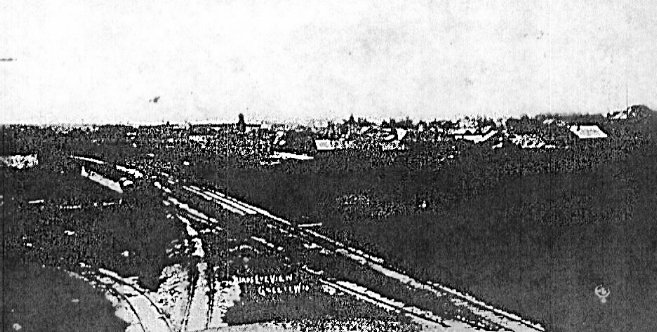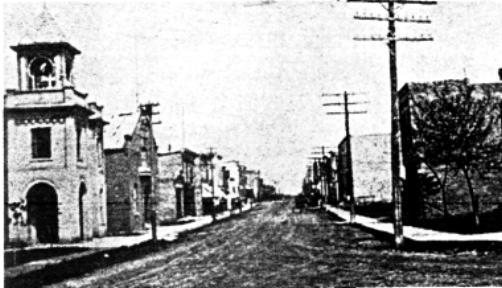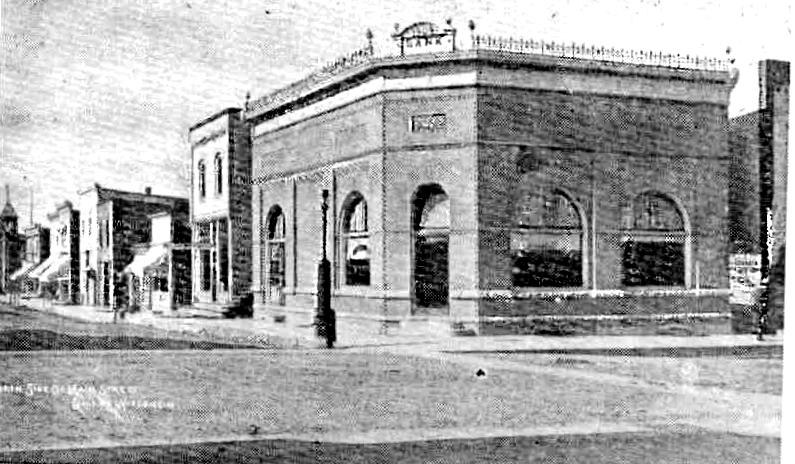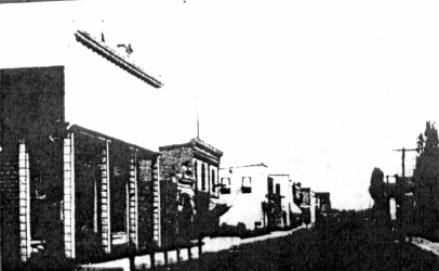
Bird's Eye View - Gillett, WI
History of Gillett
(Page 1)
In 1856 the United States assigned the land that
is now Gillett to Mr. Chauncey Baker, who reassigned it in the same year
to Mr. R. A. Jones. Mr. Jones evidently was not a lumberman, because he
sold the pine timber on this land to William Brewster, and then sold the
land back to Mr. Chauncey Baker. All of these transactions took place in
1856. The following year the down town area was sold to Edward Ramsey.
In February of 1858 Rodney Gillett of Stiles, Wisconsin and Otis Flanders
leased this land plus other lands for a term of three years. They were
to pay for the lease by clearing 40 acres enclosing it with a rail fence
7 rails high, and leaving 4 1/2 tons of English hay on the premises at
the expiration of their lease. Mr. Ramsey agreed to pay for all necessary
improvements that Mr. Gillett put on the premises. Mr. Gillett operated
under this lease from Feb-ruary of 1858 until October of 1858 when for
some reason he deemed it was wiser to clear and improve his own land, so
in October he purchased an Interest in this property and other properties
from Mr. Ramsey for $600. In 1860 Edward Ramsey sold his undivided half
Interest in the land to Mr. Gillett and his wife Mary who held the land
all during the period of the Civil War, until shortly after the surrender
at Appomattox Court House, then sold their belongings in this part of Wisconsin
to Conmink Tourtilott, on a deed dated May 15, 1856. Mr. Tourtilott deeded
the land back to Rodney Glllett just 5 months later, October 15, 1865 except
for three acres he had sold to William John.

Bird's Eye View - Gillett, WI
In 1884 Rodney Gillett and Uri Balcom hired Mr. M.A. Eaglestion to survey and map the land south of the railroad track and to designate the boundaries of the Village of Gillett. This map is on file at the Court House in Oconto in Vol. 41 of Deeds, page 467. The original plat extended from McKenzie Street and 1st Street. In addition a small triangle of land across the track, now a part of the park was included.
Mr. Gillett began immediately to sell lots along the present Main Street in Gillett. The first of these was sold to Alfred L. Cary of Milwaukee in October 1884. Ten years later Mr. Gillett and his wife Mary were able to resolve their financial difficulties with full satisfaction of their indebtedness recorded in May of 1894.
John Klemp who had been a buddy to Charles McKenzie and Joe Helmke in the Civil War came to Gillett in 1878 and opened a blacksmith shop (the first). He sharpened plow shares, shod horses, and did general repair work.
(page 2)
As the timber disappeared
and lumbering became a vanishing Industry, the nature of the store business
changed too. The farmers worked hard all week, and cane to town on Saturday.
The weekly trip to the store was combination business trip, community gathering,
carnival, fair, and clearing house for news. On Saturday night, chores
were done a wee bit early, and everyone helped Mom and Dad. The man of
the house bathed, shaved and dressed while Mother dressed her-self and
her brood for the first enjoyable stage of the Sabbath week-end. A hol-iday
spirit prevailed. The next day was Sunday when a minimum of work was done
and family and friends came to visit. Mother was ready for any number of
guests, with fresh crusty bread, spicy coffee cakes, pies and cakes crowding
the larder. When the supper work was finished and everything was spotless
for the next day, all members of the family piled into the "old tin Lizzie"
and headed for town. The lights the crowds, the wonderful things piled
high in the stores kept the children speechless. There were no carts to
be pushed, no packaged groceries to be selected. The older folks were happy
to wait their turns for service. Neighbors crowded the aisles and relayed
the week's news. It was almost with reluctance that Horn stepped to the
counter when the storekeeper said, "You're next." She handed him her crates
of eggs and they were whisked away to be counted and candled by someone
in the back room while the clerk weighed and measured her purchases and
piled them high on the counter before her. Then came the accounting which
was almost a game. Would the eggs pay for the pur-chases? Some times Mom
had a little "egg money" left over to put into the blue teapot in the cupboard
against a purchase sometime in the future of a special treat for some member
of the family, and sometimes Dad was summoned to the counter to dig deep
into his Jeans for the dollar or two needed to bal-ance the account. The
groceries were packed into the empty egg crates and car-ried to the car.
How did they always seem to fit just right?

A bank in a community is always important to its industrial development. The first bank was built about 1901 by L. B. Stuelke with L. J. Newald as the first banker. Soon it became too small, and so Mr. Newald built the old Citizens State Bank in 1904—the building on the north-west corner of Lake and Main.

A few years later H. H. (note: F. F.) Koske bought interest in the bank, and operated it efficiently until his death. He was instrumental in the development of many businesses and industries in the community. A story is told about the completeness and accuracy of his bookkeeping. Items in his ledger would include loans up to $10,000 and also $.25 given to Arnold for a haircut and 5 cents to Eraa for candy. After H. H. Koske's death, his son Herb became President and managed the bank until the time of the great depression, when it was closed. The Bank of Gillett across the street had been organized by a group of citizens in 1920, including J. M. Ankerson, Jacob Helf, and others, and was referred to during the 1920 s as "The New Bank." Later the Bank of Gillett merged with The Citizen's State Bank.
SATURDAY NIGHT AT THE STORES: In the early days stores
were quite different from the ones we know today. There was less variety
and groceries came In bulk and were weighed and packaged by the grocer
at the time of the sale. The earlier merchants were open for business from
6 a.m. until 10 p.m. six days a week, and on Sundays until noon. The automobile
changed the buying habits of the pub-lic and also made the merchants desire
more freedom.
(Page 4)
But Saturday night in town was by no means over
when the groceries were stowed away. When the weather was bad the people
moved to the front of the store, and continued their visiting. Babies sleeping
or cooing or screaming, were laid on the platform back of the window display,
with Mothers nearby and alert to their needs, but visiting with each neighbor
as she came past. But the nicest evenings were those warm and pleasant
enough to allow the groups to gather on the street corners. Each corner
was crowded. These nice summer evenings, revival singers brought their
instruments and sang repentance into the hearts of their listeners. The
music was sweet and harmonious. The kids, if they were extra good and extra
quiet, could have an ice cream cone before going home. Then too, there
was the anticipation of the enjoyment of the treat they had seen the grocer
slip into the egg crate before they took it from the store.
The community leaders took advantage of these Saturday night gatherings to meet and greet the farm people as they stood on the corners. Sometimes, in appreciation for their loyal and continuous patronage, a free movie was pre-sented, with benches, camera and screen set up on a vacant lot.
Often on Saturday nights there were dances in the pavilion with everyone joining in the circular two-steps, square dances, even the eight and ten year olds. It was not uncommon to see a man of 75 or 80 dancing a lively number with a neighbor's little girl.
There was no nine o'clock curfew then. Stores stayed open as long as there was a customer to be served often past midnight. If the storekeeper was was not entirely exhausted, he hurried to join the fun before the crowd went home. One by one, the cars pulled away until the streets were quiet and de-serted. Next morning they came again, with families clean and fresh and rest-ed looking, going to church. After the services they hurried home on to a neighbors to share once more the news collected the night before. And Sunday night, with everyone happy and exhausted, they settled down early, for Monday started the work week again. But they had only six days to wait until it was Saturday night.
